
Reading Time: 15 minutes
Long readWritten by Amina Shah

If libraries didn't already exist, we would surely invent them. They are a concept loose enough to be adapted to many needs: small, large, local, national. A democratic space, a memory holder, an ideas incubator, they are a place where everyone can sit with the genius of humankind. Where there is light.
We often hear that "Libraries change lives", and I know that to be true firsthand. They have changed my own life, chapter by chapter, starting from before I was even born. My mum, from Glasgow, was one of nine. She met my dad, an overseas student from Pakistan, in the Mitchell Library when she was a library assistant there. Where else could these different lives collide but in a free civic space in the heart of a busy city? An oasis, open and welcoming to all, where old stories are shared, and new stories are written.
My journey through libraries has let me witness what they do and what they are, both for individuals and communities.
Discovering libraries as a child
Moving house was a constant in my childhood, but so were libraries. Whiteinch Library, built in the 1920s, was my first after we moved back to Scotland from Pakistan, where I was born. We would visit after feeding the ducks in Glasgow's Victoria Park. Picture books for me, and 'The Far Pavilions' or 'Tuppence to Cross the Mersey', as well as a laugh with old colleagues, for my mum.
Wester Hailes Library in Edinburgh was next. We visited in the '80s. It was bright and light with enough room for my wee brother's Silver Cross pram. 'Miffy' and rhyme times brought it to life. A play bus parked outside. Midwives and community workers connecting with people through the space.
Later, Morningside Library was the first of my independent visits. Books were precious birthday and Christmas gifts; all others had to be loaned. A bag of sweeties in hand, I would push through the doors on a Saturday and enter an exciting world of possibility. Roald Dahl and Enid Blyton would feature, naturally. But the shelves were lined with other magic transporters ready to whisk me away from my busy house to new worlds.
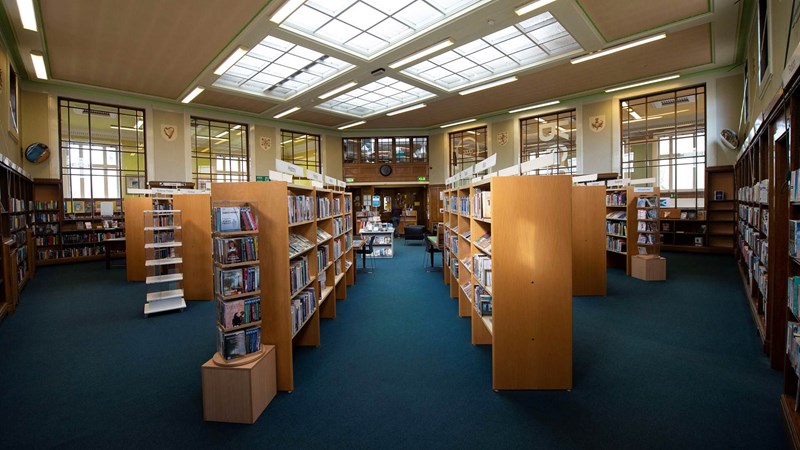
Whiteinch Library in Glasgow. Photo courtesy of Glasgow Life.
Teenage solace in libraries
Living in Blackburn, Lancashire was a lonely time for me. Moving as a teen isn't fun! The dazzling Blackburn Central Library, well stocked with teenage books, was my escape. Judy Blume, Jacqueline Wilson and all the titles that my mum would never buy me for Christmas. There were schoolbooks too, of course, 'fact' books and reference books, past papers and 'how to' guides.
Then there was my school library. It provided refuge from playground fights and the racial tensions I found overwhelming as a mixed heritage kid in a divided northern town. I would work there as a pupil librarian at lunchtime, which was mobbed with children taking out books with their little brown tickets. A time before the internet and with few channels on TV, everyone devoured books, comics and magazines. For kids who lived in busy houses, the school library provided peace for homework and respite from bullies.
I often feel that I owe Bradford City Library the greatest debt. I would have no A Levels without it. They were my access to a life of my own design. It was there, just a few miles from Haworth, that I stumbled on 'Wuthering Heights'. I found Sylvia Plath, James Joyce and George Elliot right next to Salman Rushdie, Hanif Kureishi and Maya Angelou. Lost one day, I opened a door I hadn't been through before. I was astounded to see the record library, a glistening treasure trove of music. All free to take home and play – and never forget.
Academic sanctuary in university libraries
Dundee University Library was a place of calm and warmth away from my cold and hectic student flat. Never one for using the green screen old catalogue systems, I stood in the literature section and absorbed books for my degree, breathing them in. Each one made me hungry for the next. Sometimes I would jump on the bus to the library at the University of St Andrews with its famous yellow carpet. Once a legal deposit library, they had almost everything you could imagine. And all that just a short walk from the beautiful West Sands.
The Andersonian at the University of Strathclyde gave me my first library job (and precious gifts – Alison and Lorna, two of my closest friends!). It also inspired me to do a postgraduate degree, during which I worked in Waterstones, the first of the 'big bookshops' in the style of a library. It was the mid '90s, a boom time for literature with a packed-out shop and incredible author events. I came across Arundhati Roy and Will Self, as well as Scottish stars Denise Mina, Val McDermid and many more. After graduating, I moved back to the Mitchell to work on the digitisation of Sir Thomas Lipton's archive, one of the first projects of its kind.
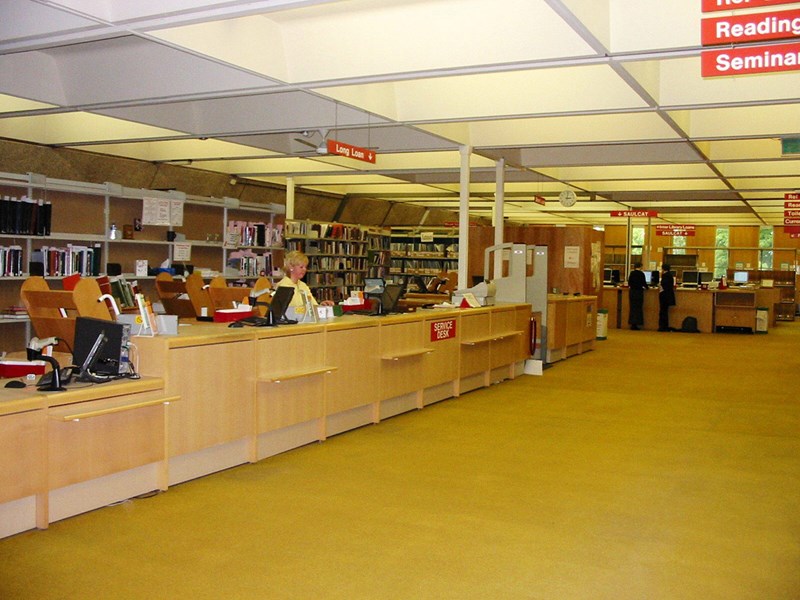
The service desk in the library at the University of St Andrews before it was refurbished. Photo courtesy of the University of St Andrews.
Starting a career in libraries
Based in the Arts Department of the Mitchell Library, I made another lifelong friend, Derek. I was hugely fortunate to work with many who were generous in passing on their knowledge. I was awestruck by the collections and the ethos. The collections and library were a gift for the people, belonging to the people.
There was an entire room dedicated to Burns; maps from centuries past, when the world had 'parts unknown' (at least to those who made the maps); Audubon; Martin Luther's signed bible; and the artefacts from the famous Madeline Smith trial. Stories, memories, treasures. Edwin Morgan poems arrived after regular visits. Beautiful exhibitions were conceived and put on. Reference questions came in from across the world every day by letter and phone call (and eventually email). It was magic. I was well and truly under its spell.
I started working on my Chartership in Librarianship at this time and that took me to the inspirational Glasgow Women's Library (GWL). I am now a proud Board member of GWL which has been working hard to celebrate stories of women's lives for over thirty years. I volunteered with them briefly when they were in a small space on Argyle Street. Back then, having their own dedicated library building, like the one they're in now in Bridgeton, was just a dream.
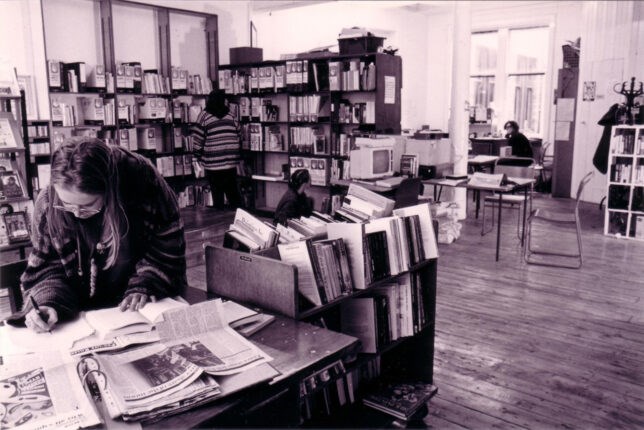
Inside the Glasgow Women's Library at their 109 Trongate space in the early 1990s. Photo courtesy of the Glasgow Women's Library.
A lifelong library career
After a time supporting Scotland's educators on the leafy campus of the beautiful Jordanhill Teacher Training College Library, I moved to Dundee where I worked for 14 years. I started out as the Art and Music librarian in the busy Dundee Central Library based in the Wellgate Shopping Centre. This was also where I met my partner, Kevin.
Our regulars (and there were many since Dundee was the busiest library service in Scotland!) loved their music. They'd borrow CDs and tapes, from Elgar to Elvis, multiple times a week. The music scores were used by organists playing at funerals and weddings, as well as young Dundee musicians gigging and busking.
Videos, and later DVDs, were often Saturday treats from Grandparents looking after wee ones. Audio books were a lifeline for those who loved stories but could no longer see well enough to read them, or those who liked to listen to them while doing domestic tasks. This sounds obvious to us now in our world of podcasts and online audio books, but it was magical at that time. My mum downloads audio books from Leeds library today – essential for her now she is visually impaired.
The early 2000s was a time of great change for libraries. We put in computers to help people access the internet. We built communities through work with the International Women's Centre, substance misusers, school refusers, young parents, job seekers, carers, and those living with dementia. The libraries there were, and still are, the beating heart of the community. I learned so much from colleagues and from the community themselves. Community libraries are quite literally a lifeline to so many.
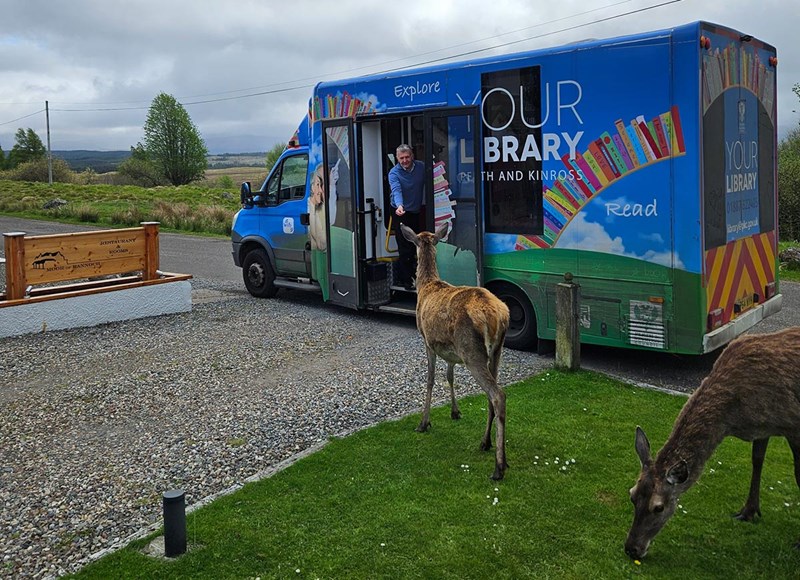
Culture Perth and Kinross's mobile Library at Rannoch Station in 2023. Photo courtesy of Moor of Rannoch Restaurant.
Community transformation through libraries
My next role was at the Scottish Library and Information Council. This gave me the privilege of seeing the impact libraries have right across Scotland. While working on the National Strategy for Public Libraries, I visited services big and small across all sectors. Stories from Dumfries and Galloway capturing oral histories of Lockerbie; author visits and creative writing classes for those in Peterhead Prison; children's reading clubs in Inverclyde; code clubs in Edinburgh; mobile libraries in rural Perth and Kinross; and social media promotions from Orkney and Shetland.
These libraries were touching lives and supporting communities in more diverse ways than I could have imagined. The range is amazing. College libraries providing bespoke support for their diverse student groups. University libraries working together to get the best deals for their students, supporting wellbeing and community building as well as space and resources. School libraries, inexplicably having to defend their place in the state education system. Meanwhile, their colleagues in private schools had funding and facilities they could only dream of (because the system they worked in understood that, for a very small investment, the school library supports positive results for education and for wellbeing for all).
I moved out of libraries to work at the wonderful Scottish Book Trust. This only brought libraries closer into view for me. Bookbug, Book Week Scotland, Schools programmes, author visits, creative writing groups, and more were all delivered in partnership with the amazing, but somehow ever shrinking and more challenged, networks of libraries and librarians.
I was back in St Andrews during the days of COVID. The community of the library was suddenly unavailable to students who visited more than a million times a year. Resources and support moved online at speed, but a huge library-shaped hole was formed in the heart of university campuses everywhere. Students and researchers desperately needed their 'lab' back. The library space, the books, the community which allowed them to work and produce. The space away from homes and offices that offered smiles and connection, supporting wellbeing.
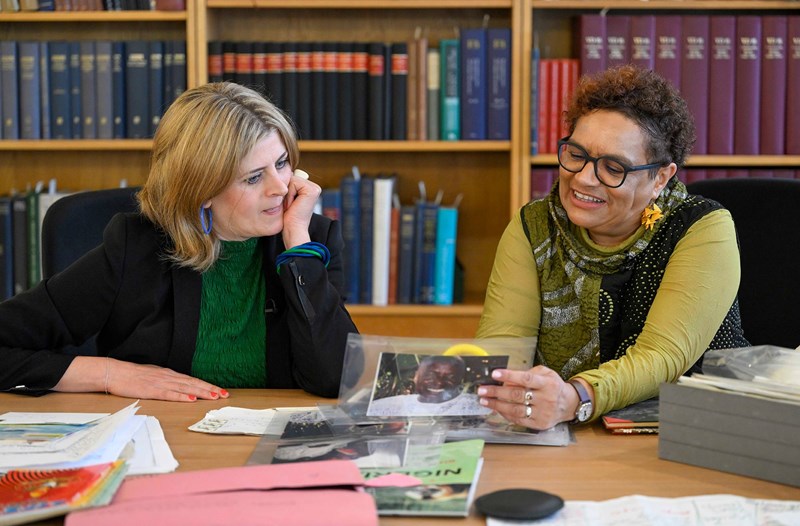
Poet and novelist Jackie Kay at the National Library of Scotland with National Librarian Amina Shah.
Becoming the National Librarian
I have somehow found myself at Scotland's National Library as it celebrates its Centenary. This is a privilege I could barely imagine growing up. I certainly didn't have a map or a plan, but looking back at my journey, perhaps I should be less surprised to find myself here. National libraries, like all other public libraries, are for everyone. They belong to and are made by us all.
Scotland's legal deposit library was founded on the collections of the Faculty of Advocates one hundred years ago. The National Library is a story house filled with memories, information and data. Our job is to make that heritage sing, to connect people to the collections, and support the creation of new knowledge and ideas. New stories for the future.
The collections and people are more dazzling and brilliant than I can explain in words. I urge everyone reading this to look at them for yourself, online or in person in Glasgow and Edinburgh. I guarantee you will find something that speaks to you – that speaks of you. But our one hundredth birthday can't be celebrated without also shining a light on the incredible network of libraries of which we're a part.
Libraries as a beacon of connection
Libraries are a design for life, to paraphrase the Manic Street Preachers. Libraries give people and communities power. As we consider the story we want to pass on to future generations and what sort of ancestors we want to be, let us nourish and treasure the concept of community. Of recording, collecting, sharing and making memories together.
There is amazing potential for connection within these story centres. In today's world of division, destruction and challenge, we have never needed our libraries, these lighthouses for the mind, more.
About the author
Amina Shah is the National Librarian and Chief Executive of the National Library of Scotland. She lives in Fife with her partner, four children and their dog. Unsurprisingly perhaps, she loves to read, enjoys live music, long walks in Scotland's beautiful hills, beaches and cities.



